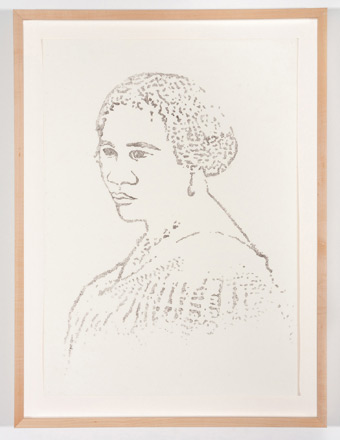Laylah Ali at Goucher College, Monsters & Myths at the BMA, and Sonya Clark at Goya Contemporary by Rebekah Kirkman and Cara Ober
This week: an exploration of the headless at Goucher’s Silber Gallery, the notion of a leaderless society as envisioned by Surrealists at the BMA, and an homage to smart, headstrong women with beautiful Black hair at Goya Contemporary.
The Friday Gallery Roundup is a curated compilation of three short reviews of three current exhibitions worth your time and consideration. There’s so much to see and do in this town every day—check out our calendar and weekly picks for even more options—but here’s a doable list of shows you can check out this weekend.


Laylah Ali: The Acephalous Series, on display through March 16
Silber Gallery, Goucher College, 1021 Dulaney Valley Road, Baltimore 21204
Weekend hours: Saturday and Sunday 11 a.m.–4 p.m.
There is the manner of “acephalous” that means “not having a head,” which has to do with some kind of creature or figure without a head—but there’s also that of a society without a leader. Laylah Ali uses the term both ways for this series, presenting humanoid beings with and without heads and conceivably without leaders, too.
In one of Ali’s paintings, a pink-skinned figure wearing a peculiar green leotard lays on the ground in supplication, grasping at the ankles of a semi-headless figure wearing a blue-and-gray-striped garment and gray sneakers. Instead of having a head atop their neck and shoulders, the standing figure’s head is attached to a cone-shaped neck emerging from the abdomen. (The cone is also vaguely genital; other figures have curlicue pigtail-like appendages or concealed button-like mounds.) The head, round and bald with purple-lined eyes, shouts down in what seems like fury toward the beggar.
Ali incorporates sociopolitical issues into her work in covert ways—the real-life referent obscured, what translates is an often inscrutable scene, but one in which power dynamics, tension, desperation, or negotiation (or some combination) are palpable. Each scene puts figures in communication, dialoguing if not with verbal language then in facial expression or bodily gesture. Sometimes one figure attempts communication, while the other looks away, ignoring them. And sometimes the method of communication is simply a scream. (Rebekah Kirkman)
 Salvador Dalí, “Soft Construction with Boiled Beans (Premonition of Civil War),” 1936
Salvador Dalí, “Soft Construction with Boiled Beans (Premonition of Civil War),” 1936
 André Masson, “Metaphysical Wall,” 1940
André Masson, “Metaphysical Wall,” 1940

Max Ernst, “Europe After the Rain,” 1942
Monsters & Myths: Surrealism and War in the 1930s and 1940s, on display through May 26
Baltimore Museum of Art, 10 Art Museum Drive, Baltimore 21218
Weekend hours: Saturday and Sunday 10 a.m.–5 p.m. Tickets available online. (Regular museum hours: Wednesday–Sunday 10 a.m.– 5 p.m.)
Speaking of headlessness: Leaderless societies are appealing, particularly now, as nations around the world freewheel toward fascism. Having dealt with fascism and violence up close, the Surrealists examined not only the war-wrought destruction and reorganization of the body but also that notion of a leaderless society. Symbolically acephalous bodies appear in the work of Hans Bellmer, Rene Magritte, and André Masson—whose headless character Acéphale featured on the cover of George Bataille’s journal of the same name—and you can find a few of these among the 90 artworks on display at this newly opened BMA exhibition.
Tracking the Surrealists as they fled Nazis and Spanish Nationalists and sought refuge elsewhere, in leftist thinking and in psychological renderings of trauma, Monsters & Myths overwhelms the head and heart. Lately, most new contextualizations of past historical or cultural events in light of “our current political climate” seem too on-the-nose, possibly because to directly confront this stuff, even through art, is to stare directly into the void. Besides the obvious present-day analogues, what to make of the nightmarish destroyed landscape in Max Ernst’s great “Europe after the Rain II”? Or the fractured, faceless, inaccessible figures in Masson’s “The Metaphysical Wall”? If nothing else, it is always useful to see how people survived. (RK)
 Sonya Clark at Goya Contemporary, photo by Joseph Hyde
Sonya Clark at Goya Contemporary, photo by Joseph Hyde
Sonya Clark: Hair/Goods: An Homage to Madam CJ Walker, on view in the gallery through March 16
Goya Contemporary, 3000 Chestnut Ave., Mill Centre #214, Baltimore 21211
Weekend hours: Saturday, noon–5 p.m.
C.J. Walker (1867–1919) was the first self-made female millionaire in the United States but she was not included in any history book I was ever given because she was African American and mainstream American history is 99.9 percent white. Walker made her money through a line of hair care products for Black women and she became well known for political activism, philanthropy, building a giant mansion in Hudson, NY, and being generally awesome.
Sonya Clark’s third exhibition at Goya Contemporary is an homage to Walker, as well as a continuation of the artist’s ongoing exploration of Black women’s hair as a highly potent art material and power symbol. The exhibition includes a series of colorful photos, each pairing the slightly blurry face of a Richmond-area hair braider with the back of the artist’s head, displaying the unique artistry of the braider in tight focus. Titled “Hair Craft Project with Kamala” and the others’ first names such as Chaunda and Ingrid and Ife, each celebrates the dextrous creativity of the hairdresser and the versatility of the braid. The exhibit also includes two throne-like barber chairs embellished with beads and faux hair, wall sculptures made with combs, wigs, and text, as well as a portrait of Walker made with clippings of the artist’s own hair. This exhibition is a testament to the potential for contemporary art in reclaiming history, with objects functioning as compelling things of beauty as well as highly effective educational tools for those who, like me, received little to no education about historic figures who happened to be African American. (Cara Ober)










